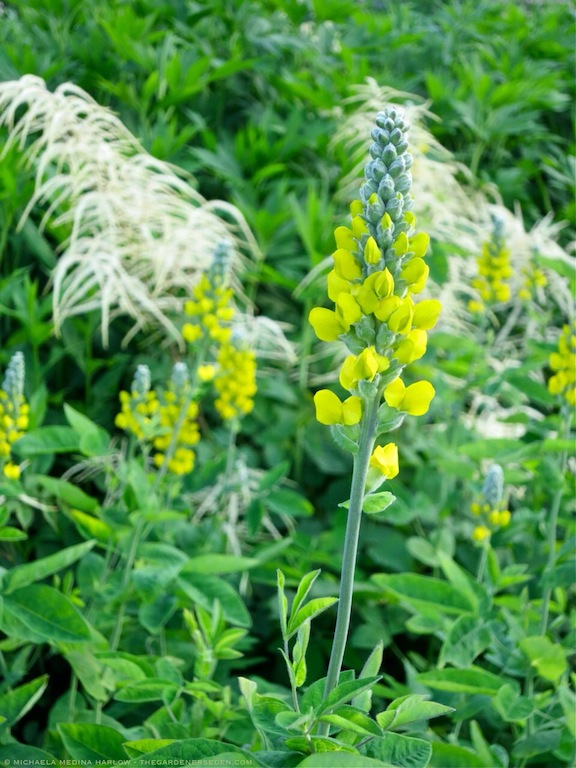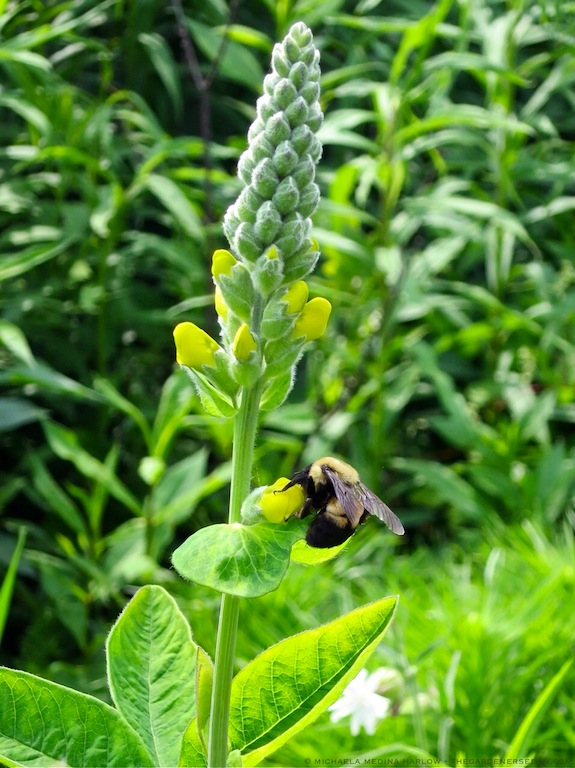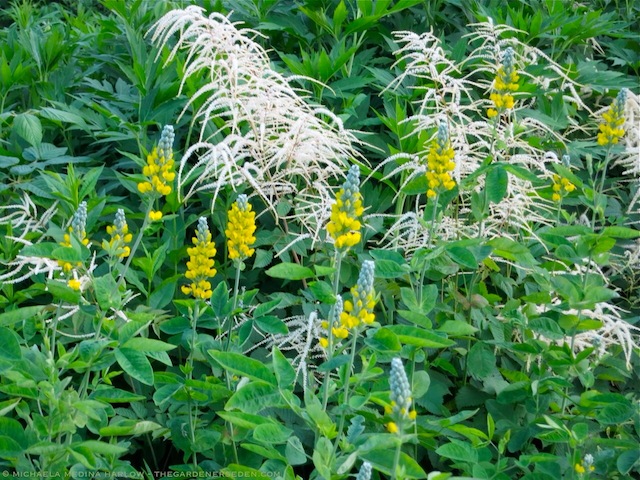Summertime’s Sweet Carolina Lupine: Basking in Her Graceful, Golden Glow
 Â Lovely North American Native, Carolina Lupine (Thermopsis caroliniana, aka Thermompsis villosa) with Goat’s Beard (Aruncus dioicus)
 Lovely North American Native, Carolina Lupine (Thermopsis caroliniana, aka Thermompsis villosa) with Goat’s Beard (Aruncus dioicus)
Oh sweet, sweet Carolina… I love how your golden blossoms illuminate the evening garden like the glow of candlelight. And on these early summer days, Carolina Lupine (Thermopsis carolina, also known as Thermopsis villosa), is quite literally covered with butterflies and bumblebees. With beautiful, long-lasting flowers —elegant and sturdy in a vase—beginning in late spring/early summer, upright/durable habit, ornamental, grey-green foliage; what more could you ask for in a perennial plant? Oh, did I mention that this gorgeous, low-maintenance beauty is a native plant? Yes, Carolina Lupine (Thermopsis caroliniana/Thermopsis villosa), is a North American wildflower!
 Bumblebees and Swallowtail Butterflies are Regular Visitors to the Carolina Lupine Blossoms in My Garden
Bumblebees and Swallowtail Butterflies are Regular Visitors to the Carolina Lupine Blossoms in My Garden
 A favorite flower of butterflies and bees, Thermopsis caroliniana is native to the open meadows and prairies of Tennessee, Virginia and the Carolinas. This 3-4′ tall, 3′ wide perennial dislikes humidity and performs best in gardens at the northern edge of its hardiness range (USDA zones 4-8); particularly those with good air circulation. High temperatures, humidity, still air and overcrowding can lead to fungal diseases and decline (try this organic, homemade remedy if fungus is a problem), so give this beauty room to move in the wind. I find the post-bloom, hairy seed pods interesting to look at, but if they aren’t to your liking, just snip them off. In addition to airflow, Carolina Lupine requires full sun and well drained soil.
  Soft, Summer Hues: Thermopsis caroliniana & Aruncus dioicus in the Native Garden
 Soft, Summer Hues: Thermopsis caroliniana & Aruncus dioicus in the Native Garden
Carolina Lupine’s bright, light yellow blossoms and pretty foliage work well with many garden design compositions. I like to combine this false lupine with ornamental grasses and other native wildflowers; including Goat’s Beard (Aruncus dioicus), Beard’s Tongue (Penstemon digitalis), Gayfeather (Liatris spicata), various Coneflower cultivars (Echincacea purpurea), Meadow Sage (Salvia nemerosa), Queen-of-the-Pairie (Filipendula rubra), and the list goes on. Dark-leafed Ninebark cultivars (Physocarpus opulifolius cvs.), such as ‘Summer Wine’, ‘Diablo’ and ‘Center Glow’ provide a dramatic, maroon contrast to bring out the yellow. If you like a bit more subtlety, try planting Carolina Lupine against a backdrop of deep, blue-green conifers or a weathered fence. Gorgeous!
Garden Design: Michaela Medina Harlow
Photography & Text â“’ Michaela Medina Harlow/The Gardener’s Eden. All images, articles and content on this site (with noted exceptions), are the original, copyrighted property of The Gardener’s Eden and may not be reposted, reproduced or used in any way without prior written consent. Contact information is in the left side bar. Please do not take my photographs without asking first. Thank you!Â
Do you enjoy The Gardener’s Eden? You can help support this site by shopping through affiliate links. A small percentage of each sale will be paid to this site, helping to cover web hosting and maintenance costs. Thank you so much for your support!

